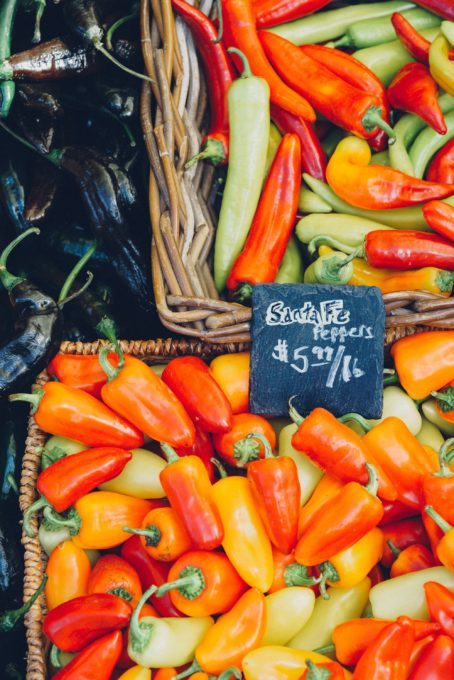7 tips to raise prices (without ticking off your customers)

A beginning farmer asked me recently, ‘I want to sell my products to restaurants. I know many restaurants usually buy from Sysco… so how do I price my products to compete with Sysco?”
In short: you don’t.
As I’ve long said, “if you compete on price, it’s a race to the bottom.” And if you don’t have the scale and efficiencies like the Dole’s and Earthbound Farms of the world (most farmers don’t), you will lose that game. If you try to match their prices, you’ll drive yourself out of business.
Seth Godin expressed it quite eloquently in a recent blog post:
If all your customers care about is price, then “brands don’t matter, customer feedback doesn’t matter, and reviews don’t matter. Neither does corporate responsibility or employee satisfaction. All that matters is the price. When we resort to a single metric, we get what we measure, the cheapest product available.”
You don’t sell a cheap, commodity product; you sell healthy, clean, sustainably raised livestock, dairy, vegetables, flowers, and fibers. Without apology, you can (and should!) sell your products at a price that respects their value and your time.
I know it can be difficult to raise prices, even though you know you should. Everything is more expensive now – one of the many brutal side effects of Covid – from basic inputs for your farm to the wages you pay your employees. Bottom line: this is affecting your bottom line! And you probably need to consider a price increase.
There are three main reasons why entrepreneurs don’t implement a price increase even though they need to:
- They don’t want to tick off their customers… and certainly don’t want to lose them.
- They underestimate the value they provide to their customers.
- They don’t realize how much even a small increase could impact their bottom line.
Let’s dig a little deeper in to these hesitations:
- Fear of ticking off customers
Consider this:
Let’s say you currently have 100 customers who pay $450 per season for a CSA share, for a total of $45,000 in revenue.
You decide to increase your price by 10% to account for your increased costs. If 9 customers leave, and now you have 91 customers buying your CSA shares, you will still have the same revenue. No doubt, it’s painful to lose loyal customers, but it’s certainly not the worst thing. Hear me out….
With fewer customers for the same revenue, you’ll have less boxes to pack and less pressure to harvest (lowering your expenses). On the plus side, you have an opportunity to increase sales to other customers.
And if price is the primary decision factor for your customers, then they’re probably not the right customers for your business.
- Recognizing your value
I’ve struggled with this issue too! A turning point for me came back in my catering days. I was cooking for a client at her home in Brookline. We were similar in age and raised in similar circumstances of privilege. We both went to college and graduated with honors. While I was “serving” her, I had to remind myself, she was no better than me nor more worthy of fine things. I wasn’t “serving” her; I was providing a service and a special experience to share with her family and friends. It was okay for me to be compensated for my work appropriately. She could afford to pay me, and I shouldn’t feel guilty about it.
- Understanding the impact on your business
Most business owners don’t increase prices just for the sake of increasing prices. They do it because their own costs have gone up. If you’re unsure how much a price increase could impact your business, try this simple exercise.
- Take a look at your 2021 Profit and Loss.
- Multiple your revenue by 10%.
- Add that number to your bottom line/net income.
That’s what profits would look like if you increased your prices, and did nothing else, across the board by 10%. Sausages that you sell for $12/pound would be $13.20. Eggs that you sell for $6/dozen would be $6.60. Lettuce that you sell for $5/bag would be $5.50. Even with these small increases they could make a huge difference to your profitability and sustainability.
And if you lose a few customers, as you may be concerned will happen, then you are still in the same place. You have upside, with little downside.
A more robust exercise:
Calculate the cost of production for your top 3 – 5 selling products. Be sure to factor in the cost of your time (even if you don’t actually pay yourself you need to add it in to the cost of production) plus the cost of equipment. Now that you know your costs, at what price would you need to sell your products to make a 50% gross margin? Keep in mind, just because you have a 50% gross margin, doesn’t mean you have 50% profit; you still need to pay for insurance, overhead and other business expenses.
When you’re ready to implement a price increase, here are 7 tips on how to do it while minimizing your customers’ discontent:
1. Communicate price changes to your customers.
Your customers understand that inputs and labor are more expensive than ever before. If you provide a meaningful explanation (a clear “why”) for the price increases, they will be more likely to accept it. You can also share details of how you tried to keep costs down. Be sure to thank your customers for their continued loyalty.
2. Communicate changes to your staff, too.
It also helps to let your staff know about price increases and messaging. If your staff talks with customers – at farmers markets or delivery runs – you want them to be able to provide the same transparency that you do.
Further, it helps your employees understand what you, as the business owner, need to do to stay profitable and continue providing value to your customers. Thank your employees for their contribution to the farm and providing value to your customers.
3. Provide Options.
One reasons costs have increased is that fewer people pay with cash. Credit card companies take approximately 3% off the top, directly cutting into a farmer’s profits. Consider offering a cash discount; or implementing a service charge for using a credit card.
You may also want to offer different package at lower prices. For a CSA, you can offer a smaller share for a lower price. At farmers’ markets, you can offer discounts on pre-packaged bundles that allow you to control your costs. For wholesale customers, you can consider bulk discounts.
4. Sliding Scales/Pay it forward.
Not all of your customers can afford to pay premium prices and will struggle with a price increase. For mission-driven businesses that want to ensure access, there are creative ways to offer sliding scales. You can offer different prices in different communities.
I’ve seen some farmers request donations as a way to subsidize costs. For those who can afford a little extra, many are willing to give.
5. Raise prices for new customers first.
New customers don’t have a history with you to know your pricing structure. This may be difficult in a farmers’ market or farm-store setting, but more realistic for CSAs and wholesale. You can graciously frame it that you’re raising prices for all customers but want to continue with the old pricing for existing customers for a period of time.
6. Raise prices regularly.
This may seem counterintuitive – that if you raise prices regularly, then you have to deal with the agita of raising prices regularly. However, if you don’t raise your prices regularly, then when you finally do it will be a steeper increase. A steep increase may be harder for your customers to accept than small, gradual increases.
7. Don’t ignore the critics.
People don’t like to see costs go up. Some of your customers will be upset. If you listen to them, and they feel heard, it can help smooth things over. And if you’ve clearly laid out your talking points (see tip #1), you’ll have an easier time addressing their concerns. That said, if the customers are too incensed at your price increases that they leave you for a cheaper option, then you’re probably better off, as difficult as it may feel in the moment. As we know, if you compete on price, it’s a race to the bottom and you will lose.
Bottom line: You deserve to be paid for the value you provide your customers. It’s not easy to raise prices, but it’s often necessary if you want to maintain financial viability.
